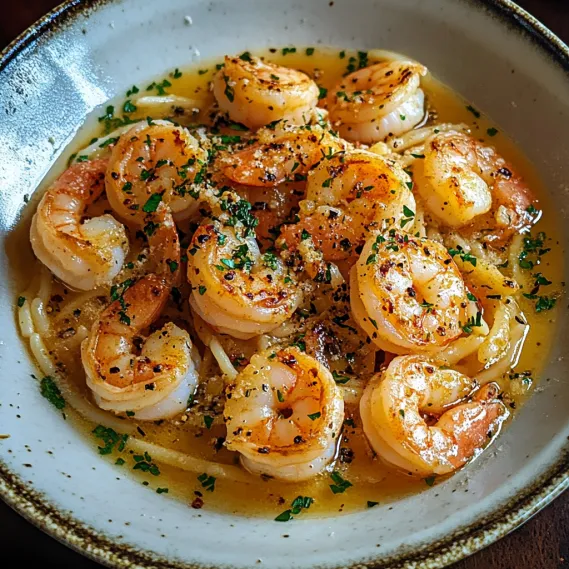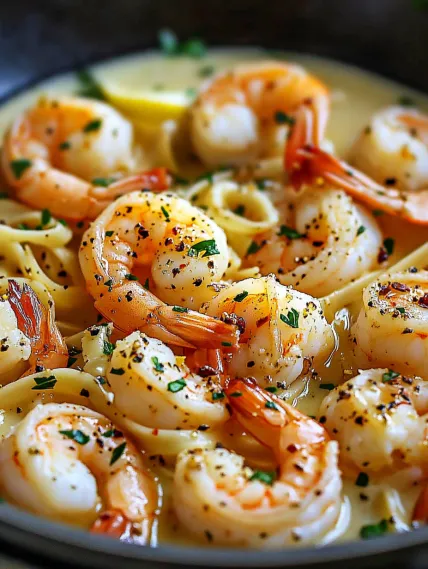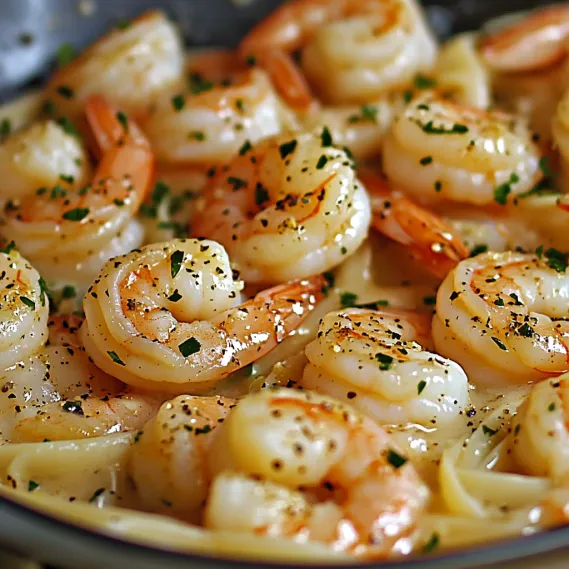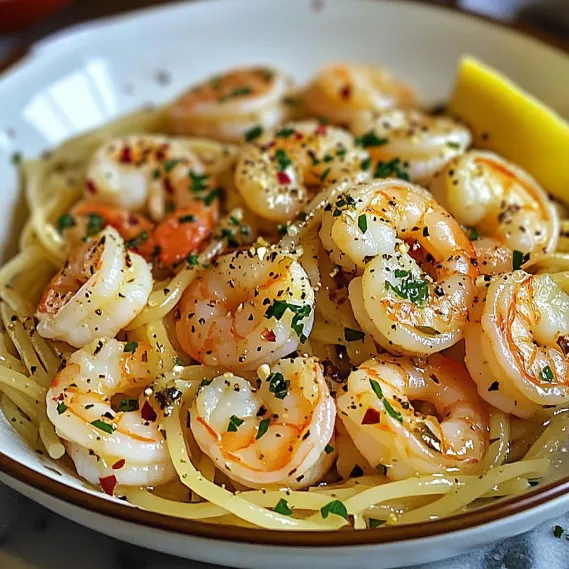 Pin it
Pin it
Juicy Shrimp Scampi turns plump shrimp into a fancy dinner without much work. Tender shrimp cook until rosy, then get drenched in a rich mix of butter, olive oil, garlic, wine and fresh lemon. It only takes 20 minutes but tastes like you went to a fancy restaurant.
I came up with this dish when I needed something wow-worthy but easy for weekend company. After trying different shrimp sizes and butter amounts, this version became our go-to favorite. My hubby says they're the tastiest scampi he's ever had, and now it's what everyone asks for when they come over.
Key Ingredients and Smart Buying Tips
- Shrimp: Pick large or jumbo ones (16-25 count), either fresh or thawed frozen
- Garlic: Use fresh cloves, chop them right before cooking
- Butter: Go for unsalted European-style for a smoother sauce
- Wine: Choose something dry like Pinot Grigio or Sauvignon Blanc
- Lemon: Squeeze it fresh to cut through richness and wake up all flavors
I've noticed that adding a tiny bit of chicken powder (bouillon) really helps get that yummy restaurant taste. Don't have any? Mushroom powder works great too - it adds that same deep flavor without changing how the dish tastes overall.
Simple Step-by-Step Cooking Guide
- Step 1: Get Your Shrimp Ready
- Dry off one pound of shrimp with paper towels and sprinkle with a bit of salt and pepper. Getting rid of extra moisture means they'll sear properly instead of steaming in the pan.
- Step 2: Start Your Flavor Base
- Mix butter with olive oil over medium heat. Using both gives you butter flavor without burning, since oil lets butter handle higher heat. It should bubble slightly but stay light colored.
- Step 3: Build Amazing Flavors
- Throw in chopped garlic and red pepper flakes into the warm butter-oil mix. Cook for about a minute until you can smell it but before it browns. This gets all that garlic goodness into the fats.
- Step 4: Cook Shrimp Just Right
- Lay shrimp flat in one layer, don't touch for 2 minutes, then flip for another minute or two until barely see-through. Take them out right away so they don't get rubbery. They'll form a loose 'C' shape when done right.
- Step 5: Make Your Sauce Sing
- Pour in white wine, scrape up the tasty bits from the pan. Let it bubble until half gone, then add lemon juice and parsley. Put shrimp back in to coat with sauce and warm up briefly.
 Pin it
Pin it
When I first tried making these shrimp scampi, I learned how important it is to get your wok crazy hot before adding anything. Now I heat mine until I see a little smoke before adding oil, and that creates that amazing restaurant flavor you can't get with lower heat. This one simple trick completely changed my homemade fried rice.
Tricks for Perfectly Separated Rice
You'll want day-old cold rice because fresh rice has too much water in it, which makes soggy fried rice. Letting rice sit in the fridge overnight dries it out a bit, so each grain stays separate when you stir-fry it. For best results, cook your rice with a little less water than you normally would.
 Pin it
Pin it
Capturing That Takeout Magic
That special flavor in restaurant fried rice comes from 'wok hei' – the smoky taste you get from super-high heat cooking in a seasoned wok. Using the hottest setting possible, cooking quickly, and keeping everything moving helps bring this taste to your kitchen. Don't worry about the sizzling and steaming – that's how you know you're getting good wok hei.
Balancing Your Proteins Just Right
What makes special fried rice stand out is all the protein goodies inside. Getting it right means cooking prawns just enough to keep them tender, making eggs into small soft bits throughout, and using char siu for those sweet-savory bites. Since each protein cooks differently, add them one after another instead of all at once.
Colorful Veggie Ideas for Better Meals
Regular special fried rice usually has green peas and carrots, but you can mix it up. Try adding chopped bell peppers, bean sprouts, sweet corn, or baby corn for more color and goodness. For that real restaurant look, keep all veggies small and the same size so they mix well with the rice.
Mistakes You Don't Want to Make
Stuffing too much in your wok cools it down, so you get steamed rather than fried rice. Too much sauce makes everything mushy. Cooking veggies too long turns them soft and bland. Throwing all ingredients in together means nothing cooks properly. And if you cook too long, your rice gets dry and hard.
 Pin it
Pin it
Smart Cooking Advice
- Break up rice lumps with chopsticks or a fork before you start cooking
- Cook everything separately first, then mix for the best texture
- Pour soy sauce down the sides of the wok to get instant caramelization
- Add a little sesame oil at the end for nutty aroma
- Keep the wok moving all the time to stop sticking and burning
- If food sticks to the pan, add a few drops of water and gently scrape with a spatula
- For a full meal, serve three or four portions as a starter or ten to twelve as the main dish
I've been tweaking versions of this pie for more than ten years, always trying to make it better. The biggest game-changer was when I started using the broiler to finish the salmon, giving it that perfect crispy outside while keeping the inside moist and juicy.
Frequently Asked Questions
- → What kind of white wine goes well with shrimp dishes?
- Dry white wines like Pinot Grigio, Sauvignon Blanc, or an unoaked Chardonnay complement shrimp well without being overly sweet. Choose something you’d enjoy drinking, as it’ll enhance the dish. If you'd rather skip alcohol, swap with chicken broth and add extra lemon for balance.
- → How do I tell when shrimp are done cooking?
- You'll know shrimp are ready when they turn from gray to a soft pink and curl into a gentle 'C' shape. Avoid overcooking—tight 'O' curls signal they’re tough. Keep an eye on them, as they only take about 2 minutes per side.
- → Can frozen shrimp be used for this dish?
- Frozen shrimp are a great option—sometimes fresher than store-counter offerings. Thaw them overnight in the fridge or rinse under cold water for a few minutes. Dry them off before cooking to ensure a better sear and no watery sauce.
- → What’s the best pasta to serve this with?
- Thin pasta like linguine or spaghetti pairs beautifully with the sauce. For sturdier options, fettuccine works too. Want something fresh? Zucchini noodles give a low-carb twist that still highlights the flavors.
- → How can I make this meal without dairy?
- Swap butter with olive oil or a dairy-free alternative. Skip the Parmesan, or try a plant-based substitute for similar seasoning. The dish won’t lose its charm, as the garlic, lemon, and wine provide most of the flavor.
